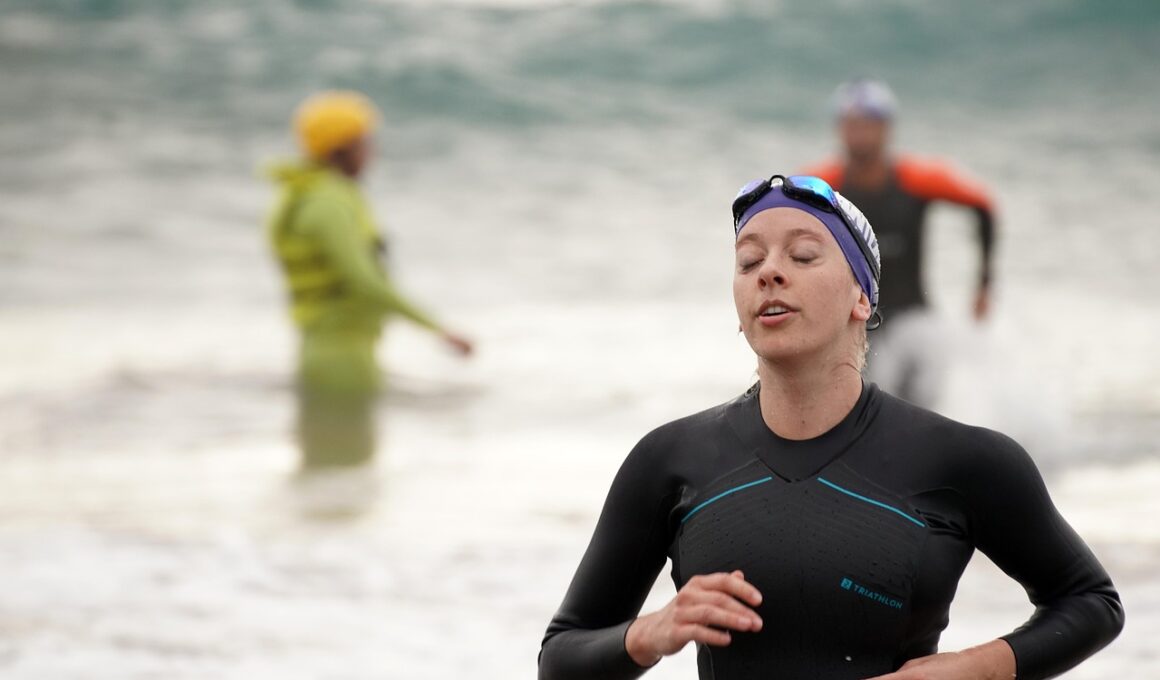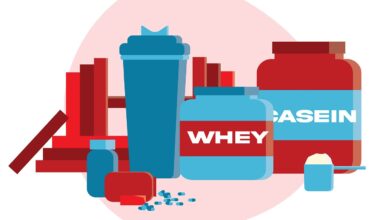Cross-Training Techniques for Triathlon Beginners
Embarking on a triathlon journey can be exciting yet overwhelming. To excel, beginners must focus on developing a balanced approach to training. One effective method is implementing cross-training techniques that can enhance overall performance in swimming, cycling, and running. By diversifying workouts, athletes can reduce the risk of injury, stave off boredom, and improve cardiovascular fitness. Consider incorporating various activities into your routine, such as strength training, yoga, or Pilates, which not only aids muscle development but also improves flexibility and balance. Each of these activities serves specific purposes in a triathlete’s training plan. Moreover, they allow you to engage different muscle groups while offering mental breaks. For example, strength training can enhance power output, while yoga restores flexibility and promotes relaxation. It’s crucial for beginners to allocate time for these cross-training sessions between the main disciplines to achieve a well-rounded performance. Staying disciplined about your training regimen is key. Proper scheduling ensures each session effectively contributes to peak race day readiness. Keep your training varied, motivating, and progressive as you work toward becoming a well-rounded triathlete.
As you progress, it’s essential to monitor your body’s response to these diverse training regimens. Assess how each cross-training method affects your performance in swimming, cycling, and running. A solid track of your training sessions can highlight areas needing attention or improvement. For example, if you find that strength training enhances your cycling speed and endurance, consider increasing the frequency of these workouts. Implementing cross-training should be an adaptable strategy, allowing you to pivot based on your evolving fitness needs and race goals. Finding the right balance between disciplines is paramount; thus, listen to your body closely and adjust accordingly. Small tweaks to your schedule can lead to significant gains in your overall performance. Consult seasoned triathletes or coaches for additional insights to refine your approach. Furthermore, consider joining local training groups, providing valuable networking opportunities and sharing collective wisdom. Social support fosters motivation, especially in challenging phases. Engaging with peers who are also training for triathlons can keep you accountable. Participation in group workouts often enhances the experience and boosts enthusiasm, especially when fatigue sets in during the training periods. Together, you can push each other towards achieving race-day success.
Incorporating swimming drills into your weekly routine is another crucial aspect of triathlon cross-training. Swimming is a highly beneficial workout component that promotes endurance without harsh impact on the joints. Begin by focusing on various techniques, such as stroke improvement and breathing patterns. Drills like the “catch-up drill” and “one-arm swimming” are excellent for refining form and efficiency in the water. Masters swim classes and local swimming clubs can offer structured guidance for beginners seeking to enhance their technique. Another advantageous cross-training technique is cycling. Incorporating interval training or hill repeats can vastly improve cycling strength. Consider exploring local cycling clubs, where you can experience group rides that motivate and push you to improve exponentially. Moreover, these outings allow you to familiarize yourself with various terrain types, presenting additional challenges. Finally, maintaining your weekly brick workouts is essential for transitioning efficiently between cycling and running portions of the race. Brick workouts simulate race conditions, allowing your body to adapt to the sudden change in activity. Aim for consistent practice of these key transitions to avoid discomfort during your actual competition.
As you start running, be sure to mix in different types of runs to boost your performance. Beginner triathletes can benefit significantly from incorporating long, easy runs and speed workouts. Long runs build endurance, while speed intervals develop speed and improve running economy. Steadily increasing the distance of runs while allowing time for recovery is crucial. Introduce tempo runs to your regimen; these are moderately paced runs that challenge your threshold without excessive fatigue. A combination of these run types improves stamina without overloading your body. Additionally, consider strength training specifically targeting muscles used in running. Exercises like squats and lunges enhance both strength and power, crucial for long distances. A sound core strengthens overall stability, vital for transitioning smoothly during multi-disciplinary events and maintaining form during fatigue. Finally, recovery techniques such as foam rolling and active recovery days play a crucial role in training. Adequate rest allows muscles to heal and adapt, reducing overuse and injury risks. Implement a solid cooldown routine after every training session, which promotes flexibility and aids in recovery.
Nutritional Support for Triathlon Training
A well-structured nutrition plan is fundamental for beginners. Adopt a balanced diet that supplies adequate carbohydrates, proteins, and healthy fats to support your training schedule. Carbohydrates are crucial for fueling energy and enhancing endurance. Focus on consuming whole grains, fruits, and vegetables while keeping high-sugar snacks to a minimum. Additionally, protein is vital for muscle recovery and growth, so include lean proteins like chicken, fish, legumes, and low-fat dairy in your meals. Healthy fats, such as those from avocados, nuts, and olive oil, play a pivotal role in maintaining overall wellness. Eating the right mix of nutrients forms the backbone of your dietary needs as you train. Managing hydration levels is essential as well. Adequate fluid intake plays a significant role in optimizing performance, especially during intense training sessions. Use electrolyte-enriched beverages for longer workouts, helping to maintain sodium levels. Experiment with meal timing to determine what fuels you best before and after workouts. Discovering what works for your body will ensure you maintain peak performance in both training and competition.
Listening to your body’s signals regarding nutrition can optimize training outcomes. Avoid the temptation of overly restrictive eating habits; instead, focus on nourishing your body while enjoying your meals. Meal prepping can alleviate stress during busy training weeks. By cooking wholesome meals in advance, you can maintain consistent nutrition without feeling overwhelmed after exercise. Additionally, connect with registered dietitians specializing in triathlon nutrition for personalized advice on fueling your body efficiently while training. They will guide you in setting realistic and individualized nutrition goals to align with your triathlon aspirations. Remember, food plays an essential role in both performance and recovery. Pretraining snacks high in carbohydrates and low in fat are ideal for immediate energy boosts. On race day, ensure you’re fueled adequately but not overly stuffed. Experimenting with different foods and drinks during training can reveal what sits best with your system. Finding the right products to sustain your energy over race distances is invaluable during competition. Thus, be attentive to how various foods impact your performance throughout your journey.
Integrating Recovery into Your Training
In addition to structured training, beginners must prioritize recovery. Effective recovery techniques are indispensable for sustaining long-term progress, especially when balancing various training modalities. Joint mobility exercises, dedicated stretching, and adequate sleep facilitate recovery, contributing significantly to muscle health. Plan at least one full rest day each week to allow the body to recover completely. Moreover, establishing a consistent sleep routine will help your body repair itself. Sleep promotes hormone balance, influencing muscle growth and repair. Implement restorative yoga or foam rolling as gentle recovery methods that can significantly enhance overall flexibility. Consider scheduling massage therapy to alleviate muscle tension and support relaxation. Furthermore, mental recovery, often overlooked, is essential in a triathlon training program. Practice mindfulness and relaxation techniques to calm racing thoughts, allowing your focus to shift back to enjoying your training journey. Engaging in hobbies outside of triathlon helps restore mental energy as well. Finding this balance between physical and mental recovery will keep you motivated and maintain a positive perspective during your triathlon journey. Overall, a comprehensive recovery plan is key to navigating your training successfully.
Ultimately, being well-prepared and informed about training methods and recovery techniques enables a successful and enjoyable triathlon experience. Begin to implement these cross-training strategies to hone your skills and build confidence for race day. Remember, finding enjoyment in the training process will keep you motivated and engaged throughout your triathlon journey. Celebrate your progress, no matter how small, as each step brings you closer to your goals. Surround yourself with fellow athletes who inspire you and share insights; this community aspect can elevate your triathlon experience. As you improve, consider setting specific milestones and accountability measures. Document your training, nutrition, and recovery insights in a journal for reflection. Being aware of progress not only highlights areas of improvement but fosters a sense of accomplishment. Lastly, remember to embrace the spirit of triathlon, which thrives on resilience, perseverance, and camaraderie among athletes. As a beginner, stay patient with your training journey, allowing yourself to grow and adapt. Keep pushing boundaries while enjoying the unique blend of swimming, cycling, and running that forms the exciting challenge of a triathlon. Your dedication and enthusiasm will undoubtedly pave the way for an enriching triathlete journey.


